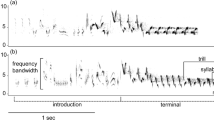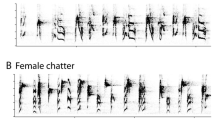Abstract
In songbirds, female mate choice may be influenced by how well a male performs his songs. Performing songs well may be especially difficult if it requires maximizing multiple aspects of performance simultaneously. We therefore hypothesized that, in a population of prairie warblers, the males most attractive to females would be those with superior performance in more than one facet of singing. We tested this prediction by comparing different aspects of song performance, as well as different combinations of these aspects, to determine which were the best predictors of first-egg date, which we took to be a proxy for social mate choice. We found that first-egg date was best predicted by a combination of song performance traits that included consistent performance, rapid rate, and low pitch. Female preference for males capable of physically challenging song performance may have contributed to the evolution of acoustically complex vocalizations in oscine songbirds, because if complex sounds are more difficult to perform, they may be favored by selection for signal reliability.


Similar content being viewed by others
References
Akresh ME, King DI, Brooks RT (2015) Demographic response of a shrubland bird to habitat creation, succession, and disturbance in a dynamic landscape. Forest Ecol Manag 336:72–80
Alatalo RV, Glynn C, Lundberg A (1990) Singing rate and female attraction in the pied flycatcher: an experiment. Anim Behav 39:601–603
Amrhein V, Kunc HP, Naguib M (2004) Seasonal patterns of singing activity vary with time of day in the nightingale (Luscinia megarhynchos). Auk 121:110–117
Bartoń K (2013) MuMIn: Multi-model inference. R package version 1.9.13, http://CRAN.R-project.org/package=MuMIn
Bates D, Maechler M, Bolker B, Walker S (2013) lme4: linear mixed-effects models using Eigen and S4. R package version 1.1-6, http://CRAN.R-project.org/package=lme4
Berg ML, Beintema NH, Welbergen JA, Komdeur J (2005) Singing as a handicap: the effects of food availability and weather on song output in the Australian reed warbler Acrocephalus australis. J Avian Biol 36:102–109
Bioacoustics Research Program (2011) Raven Pro: interactive sound analysis software (version 1.4), http://www.birds.cornell.edu/raven
Boake CRB (1989) Repeatability—its role in evolutionary studies of mating-behavior. Evol Ecol 3:173–182
Bolsinger JS (2000) Use of two song categories by golden-cheeked warblers. Condor 102:539–552
Botero CA, Rossman RJ, Caro LM, Stenzler LM, Lovette IJ, de Kort SR, Vehrencamp SL (2009) Syllable type consistency is related to age, social status and reproductive success in the tropical mockingbird. Anim Behav 77:701–706
Burnham KP, Anderson DR (2002) Model selection and multimodel inference. Springer, New York
Byers BE (1996) Messages encoded in the songs of chestnut-sided warblers. Anim Behav 52:691–705
Byers BE (2007) Extrapair paternity in chestnut-sided warblers is correlated with consistent vocal performance. Behav Ecol 18:130–136
Byers J, Hebets E, Podos J (2010) Female mate choice based upon male motor performance. Anim Behav 79:771–778
Cardoso GC (2012) Paradoxical calls: the opposite signaling role of sound frequency across bird species. Behav Ecol 23:237–241
Chiver I, Stutchbury BJM, Morton ES (2008) Do male plumage and song characteristics influence female off-territory forays and paternity in the hooded warbler? Behav Ecol Sociobiol 62:1981–1990
Christensen R, Kleindorfer S, Robertson J (2006) Song is a reliable signal of bill morphology in Darwin’s small tree finch Camarhynchus parvulus, and vocal performance predicts male pairing success. J Avian Biol 37:617–624
Darwin C (1871) The descent of man and selection in relation to sex, 2nd edn. Murray, London
de Kort SR, Eldermire ERB, Valderrama S, Botero CA, Vehrencamp SL (2009) Trill consistency is an age-related assessment signal in banded wrens. Proc R Soc Lond B 276:2315–2321
Dinsmore SJ, Dinsomore JJ (2007) Modeling avian nest survival in program MARK. Stud Avian Biol 34:73–83
Elemans CPH, Mead AF, Rome LC, Goller F (2008) Superfast vocal muscles control song production in songbirds. PLoS One 3, e2581
Foote JR, Barber CA (2009) Paired male song sparrows sing more when their mate is incubating. Wilson J Ornithol 121:819–822
Forstmeier W, Leisler B (2004) Repertoire size, sexual selection, and offspring viability in the great reed warbler: changing patterns in space and time. Behav Ecol 15:555–563
Forstmeier W, Kempenaers B, Meyer A, Leisler B (2002) A novel song parameter correlates with extra-pair paternity and reflects male longevity. Proc R Soc Lond B 269:1479–1485
Gilman S, Blumstein DT, Foufopoulos J (2007) The effect of hemosporidian infections on white-crowned sparrow singing behavior. Ethology 113:437–445
Grava T, Grava A, Otter KA (2009) Supplemental feeding and dawn singing in black-capped chickadees. Condor 111:560–564
Hasselquist D, Bensch S (2008) Daily energy expenditure of singing great reed warblers Acrocephalus arundinaceus. J Avian Biol 39:384–388
Highsmith RT (1989) The singing behavior of golden-winged warblers. Wilson Bull 101:36–50
Houlihan PW (2000) The singing behavior of prairie warblers (Dendroica discolor). Dissertation, University of Massachusetts
Houtman AM (1992) Female zebra finches choose extra-pair copulations with genetically attractive males. Proc R Soc Lond B 249:3–6
Kempenaers B, Verheyren GR, Dhondt AA (1997) Extrapair paternity in the blue tit (Parus caeruleus): female choice, male characteristics, and offspring quality. Behav Ecol 8:481–492
Kirkpatrick M (1982) Sexual selection and the evolution of female choice. Evolution 36:1–12
Krebs J, Ashcroft R, Webber M (1978) Song repertoires and territory defence in the great tit. Nature 271:539–542
Kroodsma DE (2005) The singing life of birds. Houghton Mifflin, Boston
Kroodsma DE, Bereson RC, Byers BE, Minear E (1989) Use of song types by the chestnut-sided warbler: evidence for both intra- and inter-sexual functions. Can J Zool 67:447–456
Lande R (1981) Models of speciation by sexual selection on polygenic traits. Proc Natl Acad Sci U S A 78:3721–3725
Linhart P, Jaska P, Petruskova T, Petrusek A, Fuchs R (2013) Being angry, singing fast? Signalling of aggressive motivation by syllable rate in a songbird with slow song. Behav Process 100:139–145
Mazerolle MJ (2013) AICcmodavg: model selection and multimodel inference based on (Q)AIC(c). R package version 1.35, http://CRAN.R-project.org/package=AICcmodavg
Müller W, Heylen D, Eens M, Rivera-Gutierrez HF, Groothuis TGG (2013) An experimental study on the causal relationships between (ecto-)parasites, testosterone and sexual signalling. Behav Ecol Sociobiol 67:1791–1798
Munoz NE, Blumstein DT, Foufopoulos J (2010) Immune system activation affects song and territorial defense. Behav Ecol 21:788–793
Nakagawa S, Schielzeth H (2013) A general and simple method for obtaining R 2 from generalized linear mixed-effects models. Methods Ecol Evol 4:133–142
Nolan V (1978) The ecology and behavior of the prairie warbler, Dendroica discolor. American Ornithologists’ Union, Tampa
Nolan PM, Hill GE (2004) Female choice for song characteristics in the house finch. Anim Behav 67:403–410
Owen-Ashley NT, Turner M, Hahn TP, Wingfield JC (2006) Hormonal, behavioral, and thermoregulatory responses to bacterial lipopolysaccharide in captive and free-living white-crowned sparrows (Zonotrichia leucophrys gambelii). Horm Behav 49:15–29
Pinxten R, Eens M (1998) Male starlings sing most in the late morning, following egg-laying: a strategy to protect their paternity? Behaviour 135:1197–1211
Podos J (1997) A performance constraint on the evolution of trilled vocalizations in a songbird family (Passeriformes: Emberizidae). Evolution 51:537–551
Poesel A, Foerster K, Kempenaers B (2001) The dawn song of the blue tit Parus caeruleus and its role in sexual selection. Ethology 107:521–531
Poesel A, Nelson DA, Gibbs HL (2012) Song sharing correlates with social but not extrapair mating success in the white-crowned sparrow. Behav Ecol 23:627–634
Prum RO (2010) The Lande-Kirkpatrick mechanism is the null model of evolution by intersexual selection: implications for meaning, honesty, and design in intersexual signals. Evolution 64:3085–3100
Prum RO (2012) Aesthetic evolution by mate choice: Darwin’s really dangerous idea. Philos T Roy Soc B 367:2253–2265
R Core Team (2014) R: a language and environment for statistical computing. R Foundation for Statistical Computing, Vienna, Austria, http://www.R-project.org/
Reid JM, Arcese P, Cassidy A, Hiebert SM, Smith JNM, Stoddard PK, Marr AB, Keller LF (2004) Song repertoire size predicts initial mating success in male song sparrows, Melospiza melodia. Anim Behav 68:1055–1063
Ritschard M, Brumm H (2012) Zebra finch song reflects current food availability. Evol Ecol 26:801–812
Ritschard M, Riebel K, Brumm H (2010) Female zebra finches prefer high-amplitude song. Anim Behav 79:877–883
Rivera-Gutierrez HF, Pinxten R, Eens M (2010) Multiple signals for multiple messages: great tit, Parus major, song signals age and survival. Anim Behav 80:451–459
Sakata JT, Vehrencamp SL (2012) Integrating perspectives on vocal performance and consistency. J Exp Biol 215:201–209
Shake CS, Moorman CE, Burchell MR (2011) Cropland edge, forest succession, and landscape affect shrubland bird nest predation. J Wildlife Manage 75:825–835
Spector DA (1991) The singing behavior of yellow warblers. Behaviour 117:29–52
Spector DA (1992) Wood-warbler song systems: a review of paruline singing behaviors. Curr Ornithol 9:199–238
Staicer CA (1996) Honest advertisement of pairing status: evidence from a tropical resident wood-warbler. Anim Behav 51:375–390
Staicer CA, Ingalls V, Sherry TW (2006) Singing behavior varies with breeding status of American redstarts (Setophaga ruticilla). Wilson J Ornithol 118:439–451
Suthers RA (2004) How birds sing and why it matters. In: Marler P, Slabbekoorn H (eds) Nature’s music: the science of birdsong. Elsevier Academic Press, San Diego
Suthers RA, Goller F (1997) Motor correlates of vocal diversity in songbirds. Curr Ornithol 14:235–288
Suthers RA, Vallet E, Kreutzer M (2012) Bilateral coordination and the motor basis of female preference for sexual signals in canary song. J Exp Biol 215:2950–2959
Thomas RJ (2002) The costs of singing in nightingales. Anim Behav 63:959–966
Thomas RJ, Cuthill IC, Goldsmith AR, Cosgrove DF, Lidgate HC, Proctor SLB (2003) The trade-off between singing and mass gain in a daytime-singing bird, the European robin. Behaviour 140:387–404
Ward S, Slater PJB (2005) Raised thermoregulatory costs at exposed song posts increase the energetic cost of singing for willow warblers Phylloscopus trochilus. J Avian Biol 36:280–286
Ward S, Lampe HM, Slater PJB (2004) Singing is not energetically demanding for pied flycatchers, Ficedula hypoleuca. Behav Ecol 15:477–484
Wilson DR, Bitton P-P, Podos J, Mennill DJ (2014) Uneven sampling and the analysis of vocal performance constraints. Am Nat 183:214–228
Wolak ME, Fairbairn DJ, Paulsen YR (2012) Guidelines for estimating repeatability. Methods Ecol Evol 3:129–137
Zahavi A, Zahavi A (1997) The handicap principle: a missing piece of Darwin’s puzzle. Oxford University Press, New York
Acknowledgments
We thank Victoria Phu, Rachel Xue, Ben Lagasse, and Charles Ylijoki for the assistance with song analysis and Carly Chandler, Jen Glagowski, Brodie Kramer, Tyler Maikath, Sam Roberts, Matt Smith, Greta Turschak, and Mattie VandenBoom for their excellent work in the field. This work was supported by the Nuttall Ornithological Club Blake-Nuttall Fund and the US Forest Service, Northern Research Station.
Ethical standards
The research described here complied with the current laws of the USA and was approved by the University of Massachusetts Institutional Animal Care and Use Committee (protocol # 2011-0024).
Author information
Authors and Affiliations
Corresponding author
Additional information
Communicated by M. Leonard
Electronic supplementary material
Below is the link to the electronic supplementary material.
ESM 1
(PDF 126 kb)
Rights and permissions
About this article
Cite this article
Byers, B.E., Akresh, M.E. & King, D.I. A proxy of social mate choice in prairie warblers is correlated with consistent, rapid, low-pitched singing. Behav Ecol Sociobiol 69, 1275–1286 (2015). https://doi.org/10.1007/s00265-015-1940-y
Received:
Revised:
Accepted:
Published:
Issue Date:
DOI: https://doi.org/10.1007/s00265-015-1940-y




